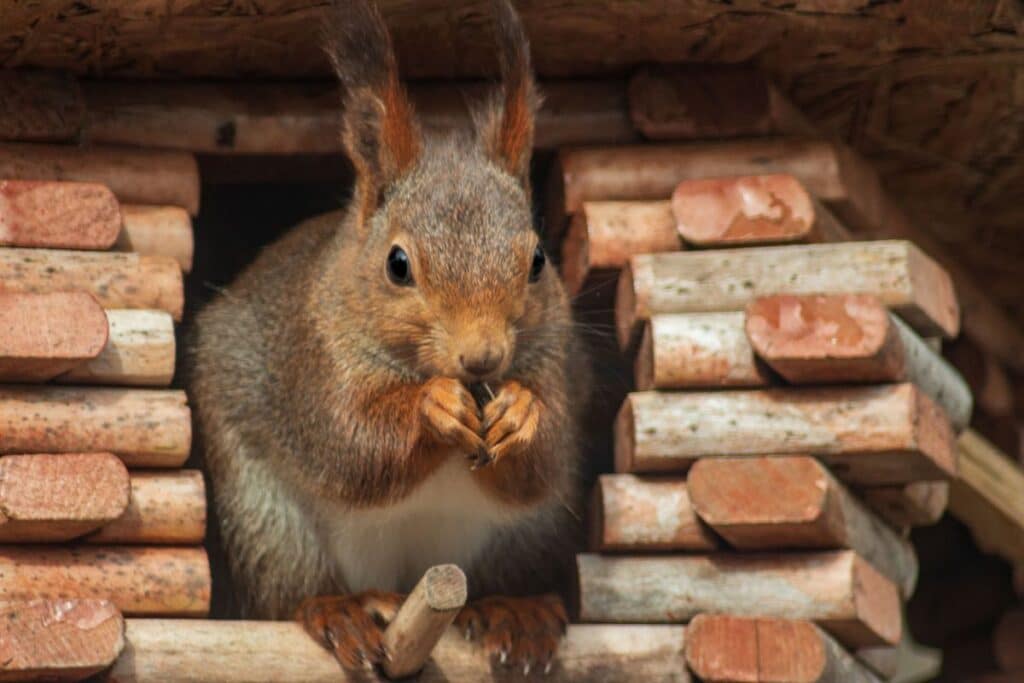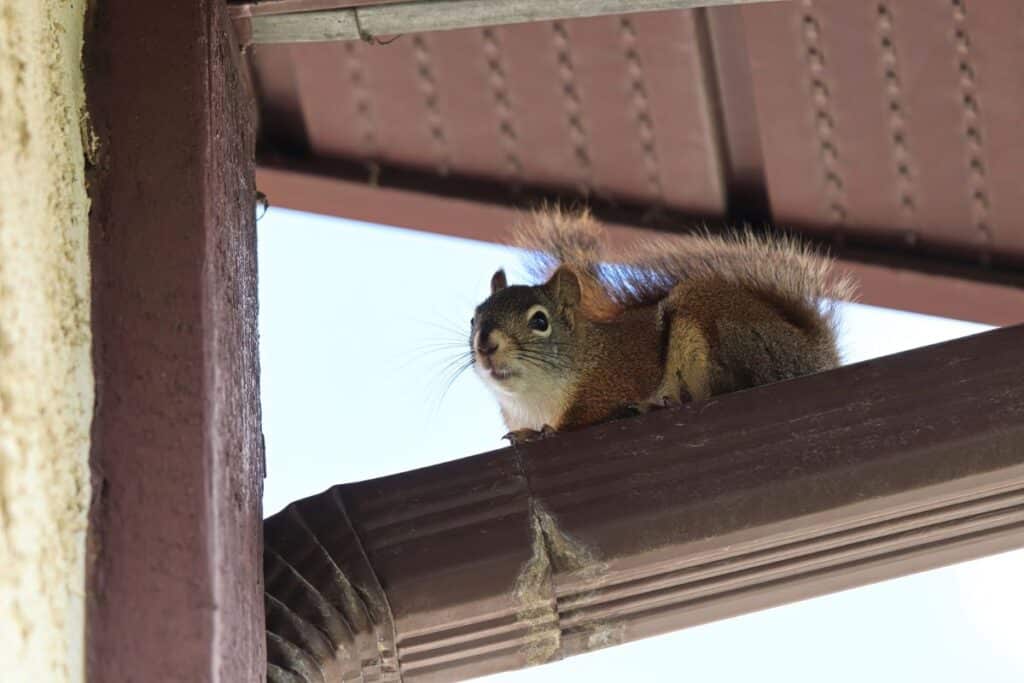Are you hearing the patter of tiny feet in your ceiling, or noticing a mysterious rustling sound that’s just a bit too heavy to be attributed to the wind? If so, you might be dealing with an uninvited guest – or even a whole family of them.
When squirrels choose your attic as their new favorite nesting spot, it can lead to a myriad of headaches that extend far beyond the noise.
Squirrels, adorable as they may appear frolicking in your yard, can become a significant problem when they take up residence in your home. The cute chatter and acrobatics quickly lose their charm when the creatures invade your attic, resulting in a full-blown squirrel infestation.
These agile rodents are more than just a nuisance – they can cause structural damage to your home, create fire hazards by chewing through electrical wires, and can even pose health risks through their droppings and parasites.
Signs of Squirrel Infestation Problem
The first step to reclaiming your attic starts with recognizing the signs of an infestation. Unusual noises at different times of the day – from scurrying sounds to the high-pitched squeals of baby squirrels – can be an initial giveaway.
Other indications may include a strong, foul odor coming from decaying squirrels that have succumbed to an unfortunate fate, or the incessant gnawing sound of teeth marks being etched into your attic’s wooden beams and electrical wiring.
Look for signs of squirrel damage, such as gnawed wood or wires, squirrel droppings, or scattered nesting supplies. This will help you determine the extent of the infestation.
Why Do Squirrels Choose an Attic for Their Nest?
It’s not by accident that squirrels, including the flying squirrels, select attics as their preferred nesting spots. These resourceful creatures seek out spaces that provide them with safety, warmth, and seclusion, all of which are qualities found in abundance in an unoccupied attic.
An attic provides an ideal environment shielded from predators and harsh weather conditions, making it a prime real estate option for a squirrel family. Moreover, the materials found within an attic, such as insulation and wooden beams, can serve as perfect nesting supplies, lending a hand in the creation of a cozy squirrel nest.
How Does Squirrel Get Inside Your Attic in The First Place?
Identifying the entry points used by squirrels is a crucial step towards successfully dealing with an infestation. Squirrels, due to their small size and impressive agility, can exploit even the tiniest of cracks or gaps in your home’s exterior to gain access to your attic.
Common entry points include visible holes, existing cracks in the attic crawl space, damaged soffits, unsealed vents, and areas where the roof and eaves meet.
Remarkably, a hole as small as 1.5 inches in diameter is enough for a squirrel to squeeze through.
By locating and subsequently sealing these entry points, you can effectively block the squirrels’ easy access to your attic, an essential measure in both removing an existing infestation and preventing future ones.
Why Should You Worry?
A squirrel infestation presents more than just a minor nuisance—it can pose serious threats to both your home and health. One of the most alarming risks stems from the squirrels’ propensity to gnaw on anything within their reach, including electrical wires.
The protective plastic sheathing on the wires, once stripped away, exposes the metal conductor. This exposed wiring poses a significant fire risk, with the potential to spark house fires if they come into contact with any flammable materials in your attic, such as insulation or wooden beams.
Furthermore, the damage caused to your home’s electrical system can lead to costly repairs, making a squirrel infestation not only a safety issue but a financial burden as well.

How to Get Rid of Squirrels in the Attic
Once you know for sure that there are squirrels in your attic, here are some tips and methods to force them out:
Use Squirrel Repellent
Various squirrel repellents can be used to deter these critters from your attic. Predator urine, such as that from foxes or coyotes, can instill a sense of danger and persuade the squirrels to vacate the premises.
Other options include mint-scented repellents and natural deterrents like cayenne pepper, which squirrels find unpleasant. This method is also effective at keeping squirrels away from potted plants.
Use Natural Deterrents
Consider making your attic less appealing to these furry invaders by using natural deterrents. The sound of a loud radio or human voices can create an undesirable living environment for squirrels. These sounds can mimic human activity, encouraging the squirrels to vacate the area in search of a quieter, safer nesting spot.
Consider Using A Trap
Using live traps can be an effective method for capturing squirrels. It’s important to remember that squirrels are often part of a larger family. Therefore, it’s necessary to trap not just one, but the entire squirrel family to prevent more squirrels from appearing.
Ensure that you’re using traps approved by the Humane Society to avoid causing unnecessary harm to the animals, especially the mother squirrel with young ones. You can release the trapped squirrel in a suitable and humane place.
Install Deterrent Devices
Lastly, installing devices specifically designed to deter squirrels can provide an additional layer of protection. This can include installing a chimney cap to prevent squirrels from entering through the chimney, or using metal collars on trees and downspouts to prevent squirrels from climbing.
In conjunction with other methods, these deterrents can significantly reduce the likelihood of a squirrel making your attic its home.
Get Professional Help If You Can
If you cannot get rid of squirrels by yourself, don’t be afraid to seek help.
While it may be tempting to tackle the problem on your own, handling wildlife can be risky and complicated. It’s advisable to contact a pest control specialist or book a squirrel removal service from any pest control companies to remove squirrels from the attic.
Preventive Measures to Keep Squirrels Out of Attic
The best way to get squirrels out of your attic and walls is to stop attracting them inside in the first place. These tips can help:
Seal Entry Points
Once all attic squirrels have been safely removed, it’s important to seal all possible entry points. This will prevent any future infestations by denying squirrels easy access to your attic. Remember, even very small holes can provide an entry point for these agile creatures.
Clean-Up Your Space
After successful removal, ensure to clean up the attic space thoroughly. This should involve disposing of any remaining nesting materials, droppings, or food remnants. A clean space will not only be less attractive to other squirrels but also reduce health risks.
Modify the Surroundings
Limiting the accessibility of your home to squirrels involves some modifications to the surrounding environment, especially the low tree branches.
Trim overhanging tree limbs and branches that could serve as launching pads for squirrels to leap onto your roof. Secure your garbage cans to deny squirrels an easy food source. Also, make sure you keep the bird feeders far from the house as they often attract squirrels.
If you have fruit trees around your house, you might want to consider growing squirrel proof fruit trees.
Secure Exhaust Vents
Ensure all exhaust vents, including those for dryers, are properly secured. Squirrels can easily crawl through these vents and gain access to your attic.
Light Up Dark Corners
Squirrels prefer dark, quiet spaces for their nests. Install an overhead light or a motion-activated light in your attic to create an unfavorable environment for them.
Proper Food Storage
Squirrels are often attracted to human food sources. Ensure your food, especially bird feed, is stored securely and out of reach. Use tight-fitting lids for your garbage cans and place the bird feeder far from your house.
Install Chimney Caps
A chimney can serve as an open invitation to a squirrel. Prevent unwanted guests by installing a chimney cap.
Regular Inspections
Finally, regular inspections of your attic and the exterior of your house are necessary to prevent future infestations. Pay particular attention to your roof and eaves, as these are common areas for squirrels to enter. By maintaining regular inspections, you can spot potential problems before they become major issues.
What Do Squirrels Eat?
Squirrels are typically omnivores, although their diet primarily consists of a wide variety of plants. They feed on seeds, nuts, fruits, and green vegetation. Acorns, walnuts, and peanuts are among their favorite food items. Some species are also known to eat small insects, caterpillars, small birds, and even eggs when other food sources are scarce.
Squirrels have also been known to raid gardens for vegetables, dig up planted bulbs, and can often be seen eating at bird feeders, indulging in seeds or suet. It’s important to note that while squirrels can eat a broad range of things, not all human food, especially processed food, is safe or healthy for them.
It’s wise to mix some squirrel resistant plants to keep squirrels out of your garden.
Final words
In conclusion, dealing with a squirrel problem in your attic can be a daunting task, but with the right strategies, it is certainly manageable. The process involves a thorough understanding of the issue, applying the right removal tactics, and taking necessary preventive measures.
Ultimately, prevention is key. Creating an environment that is less attractive to squirrels in the first place can save you a lot of time, effort, and potential damage to your home. Always remember, it is far easier to prevent a squirrel infestation than it is to evict squirrels once they’ve decided your attic is their new home.
See more:
*image by wirestock_creators&Akchamczuk/depositphotos







